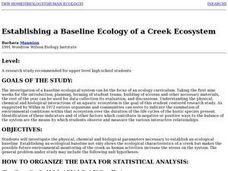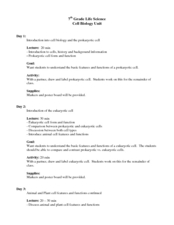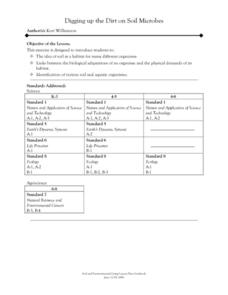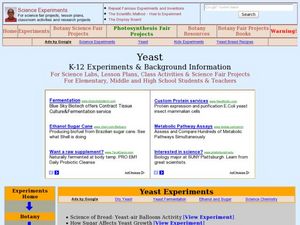Biology Junction
Elements and Macromolecules in Living Things
In this biology learning exercise, students read about macromolecules and elements in living things to answer 56 questions that follow. They also draw the molecular structure of some organic and inorganic molecules.
Curated OER
Establishing a Baseline Ecology of a Creek Ecosystem
Students investigate the physical, chemical and biological parameters necessary to establish an ecological baseline. Establishing an ecological baseline not only shows the ecological characteristics of a creek but makes the possible...
Curated OER
Carbon Dioxide Emissions
In this emissions worksheet, learners will study a graph comparing biological and industrial carbon dioxide emissions over the years and another graph showing the geographic regions of carbon dioxide emissions. Using this information,...
Curated OER
Journey to the Center of a Cell
Ninth graders create a large scale model of a eukaryotic cell. In this biology lesson, 9th graders identify the different parts and function of the cells by using a robot to navigate through the cell models. They create a video tutorial...
Curated OER
Creating the "Perfect" Horse
Students examine the relationship between a horse and its rider. In this behavior and interactions lesson students research the Internet to learn about horse behavior and biology then write a paper and present it to the class.
Curated OER
Marine Protected Areas (MPA)
Ninth graders explain the purpose of MPA's. In this biology lesson, 9th graders identify MPA's in Southern California. They simulate coastal sampling using candy from two buckets. Students analyze their results and share it with the class.
Curated OER
HIV/AIDS
Tenth graders discuss facts and myths about HIV transmission. In this biology lesson, 10th graders complete an HIV awareness poster and scavenger hunt. They simulate the transmission of the disease through a class activity.
Curated OER
Confident Commute: Increasing Safety for Teen Drivers
Students brainstorm possible causes for motor vehicle accidents involving teen drivers. In this biology lesson, students study national data regarding teen driving behaviors. They create awareness materials to help promote safe driving...
Curated OER
Tropism
High schoolers conduct various experiments on tropism. In this biology lesson, students explain how gravity affects the growth of plant roots. They identify the different types of tropisms.
Curated OER
Cell (Biology)
Young scholars conduct a series of activities to explore the nature of cells. For this biology lesson, students observe plant and animal cells under the microscope and compare them. They differentiate osmosis and diffusion.
Curated OER
Glucose
High schoolers conduct various experiments on glucose. In this biology lesson, students differentiate the process of diffusion and osmosis. They test different foods for the presence of glucose and starch.
Curated OER
Digging up the Dirt on Soil Microbes
Learners are introduced to the idea of soil as a habitat for many different organisms. They are introduced to the links between the biological adaptations of an organism and the physical demands of its habitat. Pupils are introduced to...
Curated OER
Disease & Epidemics: Architects of History
Students explore disease and its relationship to history and literature. They investigate issues that range from early biological warfare and historical disease treatments, to observing today's race for the cure against current emerging...
Curated OER
Identifying Vertebrates
For this biology worksheet, students look for the answers to how to classify animals. They specifically focus upon the vertebrates while differentiating the characteristics from other organisms.
Curated OER
Wiggley Worms
Students investigate how worms affect plant growth. In this biology lesson, students construct a worm ecosystem in a plastic 2 liter bottle and plant a seed in the soil. They later compare the ecosystems with worms to ones...
Curated OER
From Wolf to Dog
Students explain how dogs evolved from wolves based on the video. In this biology lesson, students research about breeding animals for specific traits. They interview dog owners and create a presentation about the dog.
Curated OER
Survival of the Fastest: Predator and Prey in the African Savannah
Students explore the predator-prey relationship using an interactive game. In this biology lesson, students compare their physical attributes. They explain how predators develop to make it stronger and efficient as hunters. Each...
Curated OER
Bird Brained?
Students identify general abilities that indicate animal cognitive intelligence. In this biology lesson, students create an intelligence testing challenge for ravens. They compare its ability to that of a crow.
Curated OER
Sugar Solutions
Seventh graders study biological systems and how they reach equilibrium. In this system balance lesson students divide into groups and complete an osmosis lab activity.
Curated OER
Inquiry into Infectious Disease: It's a Germy World After All
High schoolers choose a question from a given list and develop an investigation about it. For this biology lesson, students analyze bacterial growth by carrying out a guided experiment. They present their findings in class.
Curated OER
Photosynthesis
Students conduct a variety of experiments on photosynthesis. In this biology lesson, students identify the factors required for the process to occur. They perform computerized experiments to test the amount of oxygen produced when plants...
Curated OER
Yeast
Students study the characteristics of yeasts. In this biology lesson, students conduct experiments to measure yeast respiration. They discuss the favorable conditions needed for growing them.
Curated OER
Proteomics
Students analyze data taken from proteomic experiments. In this biology lesson, students explain the importance of bioinformatics tools in the study of proteins. They evaluate scientific results using math and computer software.
Curated OER
Microbes in Long Island Sound
Learners discover the harm and benefits of microbes. In this biology lesson, students explore water, nitrogen and carbon cycles. They investigate the factors affecting bacteria growth.























